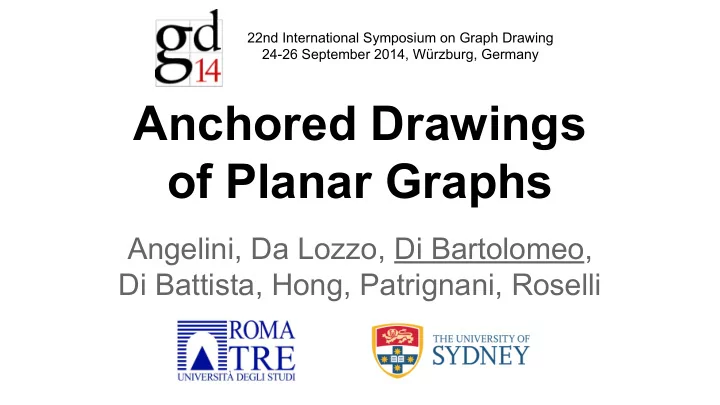

22nd International Symposium on Graph Drawing 24-26 September 2014, Würzburg, Germany Anchored Drawings of Planar Graphs Angelini, Da Lozzo, Di Bartolomeo, Di Battista, Hong, Patrignani, Roselli
Applicative Context ● Drawing a graph on a geographical map ● Vertices have fixed positions
Drawing Nicely ● Our idea: ○ Let vertices move “a bit” around their positions ○ Check if this allows a planar drawing of the graph
Anchored Graph Drawing Problem ● Instance ○ Planar graph G ○ Initial vertex positions α ( v ) ○ Maximum distance δ ● Question ○ Does G admits a planar drawing ○ ...such that vertices move by distance at most δ ○ ...from their initial positions α ?
Considered Settings Distance “Euclidean” “Manhattan” “Uniform” d = (d x 2 + d y 2 ) 1/2 d = d x + d y Function d = max(d x ,d y) Vertex d y d y d y d x d x d x Region Rectilinear Straight-line Drawing Style
Previous work ● NP-hard: straight-line and disks of different size ○ Godau. On the difficulty of embedding planar graphs with inaccuracies . 1995 ● NP-hard: rectilinear and δ = inf ○ Garg, Tamassia. On the comp. compl. of upward and rectilinear planarity test . 2001 ● Application of force-directed algorithms ○ Abellanas et. al. Network drawing with geographical constraints on vertices . 2005 ● Iterative adjustments that preserve mental map ○ Lyons et. al. Algorithms for cluster busting in anchored graph drawing . 1998
Assumption ● No overlap between vertex regions ○ Or two vertices may invert their positions ■ Very confusing for a user ○ Relationship with Clustered Planarity with drawn clusters
Our Results Metric Straight-line Rectilinear Manhattan NP-hard NP-hard d x Euclidean NP-hard NP-hard Uniform NP-hard Polynomial
Our Results Metric Straight-line Rectilinear Manhattan NP-hard NP-hard d x Euclidean NP-hard NP-hard Uniform NP-hard Polynomial
Polynomial Case ● Connected graph ● Uniform distance ( regions) ● Rectilinear drawing
Edge Pipes ● We call pipe the convex hull of two regions ○ Minus the regions ● An edge can be drawn only inside a pipe ● In this setting pipes “get rectilinear” too
Rectilinear Edges ● An edge is either horizontal or vertical ● Can be deduced by the region positions ● Visibility is required between two endpoints
Trimming ● Regions and pipes can trim each other ● A trimmed area cannot be used
General Strategy 1. Start from the initial region/pipe configuration 2. While (a trim is possible): a. Trim unusable parts of pipes and regions b. Check if a negative configuration is obtained 3. Flag the instance as positive 4. Draw edges according to the current pipes
Trimming Pipes ● VP-overlaps can trim a pipe
Trimming Regions ● VP-overlaps can trim a region
Negative Instances No visibility PP-overlap (Unavoidable crossing)
An Example of Execution
An Example of Execution
An Example of Execution
An Example of Execution
An Example of Execution
NP-hard Case ● Euclidean distance ( regions ) ● Straight-line drawing ● Reduction from Planar 3-SAT
Planar 3-SAT (x 1 ˅ ¬x 2 ˅ x 5 ) ˄ (x 2 ˅ x 3 ˅ ¬x 4 ) ˄ (x 1 ˅ ¬x 3 ˅ x 5 ) ˄ (x 3 ˅ x 4 ˅ x 5 ) C 1 C 2 C 3 C 4 x 1 c 1 x 2 c 2 x 3 c 3 x 4 x 5 c 4
Planar 3-SAT - Gadgets
Planar 3-SAT - Variable Gadget
Planar 3-SAT - Clause Gadget
Planar 3-SAT - Truth Propagation
Planar 3-SAT - Not Gadget
Planar 3-SAT - Turn Gadget
Planar 3-SAT - Split Gadget
Variable Gadget True configuration False configuration F T F T
Truth Propagation F F T T
Not Gadget F F T T
Turn Gadget F T F T
Split Gadget T F F T F T
Clause Gadget T T a F F x y F-T-T case The gadget is planar F T b
Clause Gadget T T a F F x y F-F-F case The gadget is NOT planar F T b
Clause Gadget T T F F F T
Clause Gadget T T F F F T
Clause Gadget T T F F F T
Clause Gadget T T F F F T
Clause Gadget T T F F F T
Clause Gadget T T F F F T
Open Problems ● Do the hard problems belong to NP? ● Still hard with biconnected gadgets. What if triconnected? ● What if we allow regions to partially overlap? ● What if we allow some crossings?
Applicative Context ● Drawing a graph on a geographical map ● Vertices have fixed positions
Clause Gadget (master slide) T T F F F T
Challenges ● Vertex cluttering, edge crossings ● Techniques exist to mitigate cluttering ● However, crossings are still an issue
Recommend
More recommend